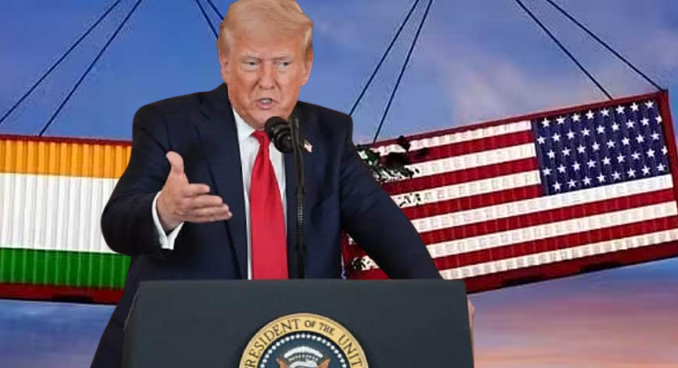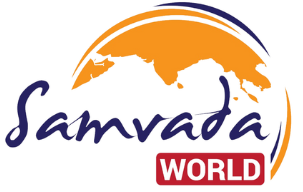
- Nearly 55% of Indian exports to the U.S. will be impacted by the new tariffs, said the Federation of Indian Export Organisations (FIEO).
- Producer cities of Tiruppur, Noida and Surat have halted production for U.S. orders, anticipating reduced profitability and order cancellations.
- The impact will be greater on MSMEs (Micro, Small, and Medium Enterprises), who have most of them not carried the financial buffer to weather such losses.
- Unless U.S.-India relations begin to stabilise, the tariff hike may be a precursor to a long-term phase of strategic decoupling between two of the world’s largest democracies.
Donald Trump, the former President of the United States, has again sparked worldwide trade tensions, levying a new 25% tax on Indian imports, raising the overall duty to 50% on an enormous range of products. This sudden spurt comes in the wake of allegations that India has been indirectly supporting Russia’s invasion of Ukraine through its continued oil trade. For India, which in 2024 shipped over $77.5 billion in goods to the U.S., the strike can be substantial—both economically and diplomatically.
India’s export-oriented industries are now under direct pressure. Nearly 55% of Indian exports to the U.S. will be impacted by the new tariffs, said the Federation of Indian Export Organisations (FIEO). Textile, leather, gems, jewellery, pharma and seafood industries will be the worst affected. Producer cities of Tiruppur, Noida and Surat have halted production for U.S. orders, anticipating reduced profitability and order cancellations. Exporters in cities like Ludhiana have threatened to cancel orders for ₹1 lakh crore, resulting in job loss and a significant fall in local production.
While the direct impact on India’s GDP appears to be small on the surface, it could have a long-term spillover impact on the economy. The tariffs are likely to affect as much as $8.1 billion worth of exports, PHDCCI said, and that is a 0.19% drag on the GDP.
But whereas economists are hopeful, analysts are not. HDFC Bank estimates that if tariffs continue, India can lose 30–40 basis points (0.3–0.4%) of GDP growth, short of the Reserve Bank of India’s estimate of 6.5%. Fitch Ratings has just lowered India’s FY26 growth estimate marginally, to 6.3%, on the grounds of external trade risk as a consideration.
MSMEs and the Consumer Chain
The impact will be greater on MSMEs (Micro, Small, and Medium Enterprises), who have most of them not carried the financial buffer to weather such losses. These are the pillars of India’s export-oriented labour-intensive sectors and are now experiencing profit squeezes and downsizing. On the contrary, Indian consumers and buyers will likely end up paying higher prices for American goods, compelling American companies to redirect sources to competitors like Vietnam or Bangladesh.
Trade Relations at a Crossroads
It’s a diplomatic low as well. The two countries were negotiating agreements last summer to trade energy and defence equipment and lower tariffs on whiskey and motorcycles. Now, that momentum has been disrupted.
While preparing for the immediate impact of U.S. tariffs, India stands at the threshold of a significant strategic gain. Due to its comparatively lower tariff exposure and recent trade pacts, multinationals are looking increasingly at shifting production to India as part of a “China + 1” rebalancing, supported by Moody’s and HSBC analysis. The smartphone and electronics sectors are spearheading this shift, with India’s share in the global smartphone manufacturing increasing to 25–28% by 2026 and Apple expanding its local assembly business in India. India’s strong domestic demand, macroeconomic stability, competitive exchange rate, and targeted incentives (including the PLI scheme) add to its attractiveness as well.
In Parallel, India can strike back by expanding export markets to the EU, Latin America and Southeast Asia and boosting domestic consumption and encouraging import substitution. But unless U.S.-India relations begin to stabilise, the tariff hike may be a precursor to a long-term phase of strategic decoupling between two of the world’s largest democracies.
References:
- https://www.ibef.org/indian-exports/india-us-trade
- https://www.indiatoday.in/business/story/trump-tariff-news-impact-india-economy-sectors-hardest-hit-gem-jewellery-auto-labour-textile-seafood-export-2767607-2025-08-07
- https://www.indiatoday.in/business/story/us-tariff-25-percent-import-duty-imports-phdcci-report-impact-india-economy-minimal-trump-2767228-2025-08-06?utm
- https://economictimes.indiatimes.com/news/economy/indicators/indias-gdp-likely-to-dip-30-60-bps-in-fy26-amid-us-tariffs-but-opportunities-ahead/articleshow/119967375.cms?
- https://www.reuters.com/world/china/trump-tariffs-hit-indias-garment-makers-us-buyers-say-move-production-2025-08-07/
- https://www.business-standard.com/economy/news/missed-signals-rising-tensions-how-india-us-trade-talks-fell-apart-125080600244_1.html?
- https://economictimes.indiatimes.com/news/economy/foreign-trade/tariff-to-have-negligible-impact-diversification-remains-key-phdcci/articleshow/123144665.cms?
- https://bfsi.economictimes.indiatimes.com/articles/india-positioned-as-key-winner-in-global-supply-chain-realignment-hsbc/121905164?
- https://www.ft.com/content/d46e0faa-33f2-41a5-9c09-3957b0deac6f?
Tejashree P V holds a Master’s degree in English Literature from IGNOU and a Bachelor’s degree in Journalism, English, and History from Vivekananda Degree College. A UPSC aspirant, she has a keen interest in international affairs, geopolitics, and policy.
